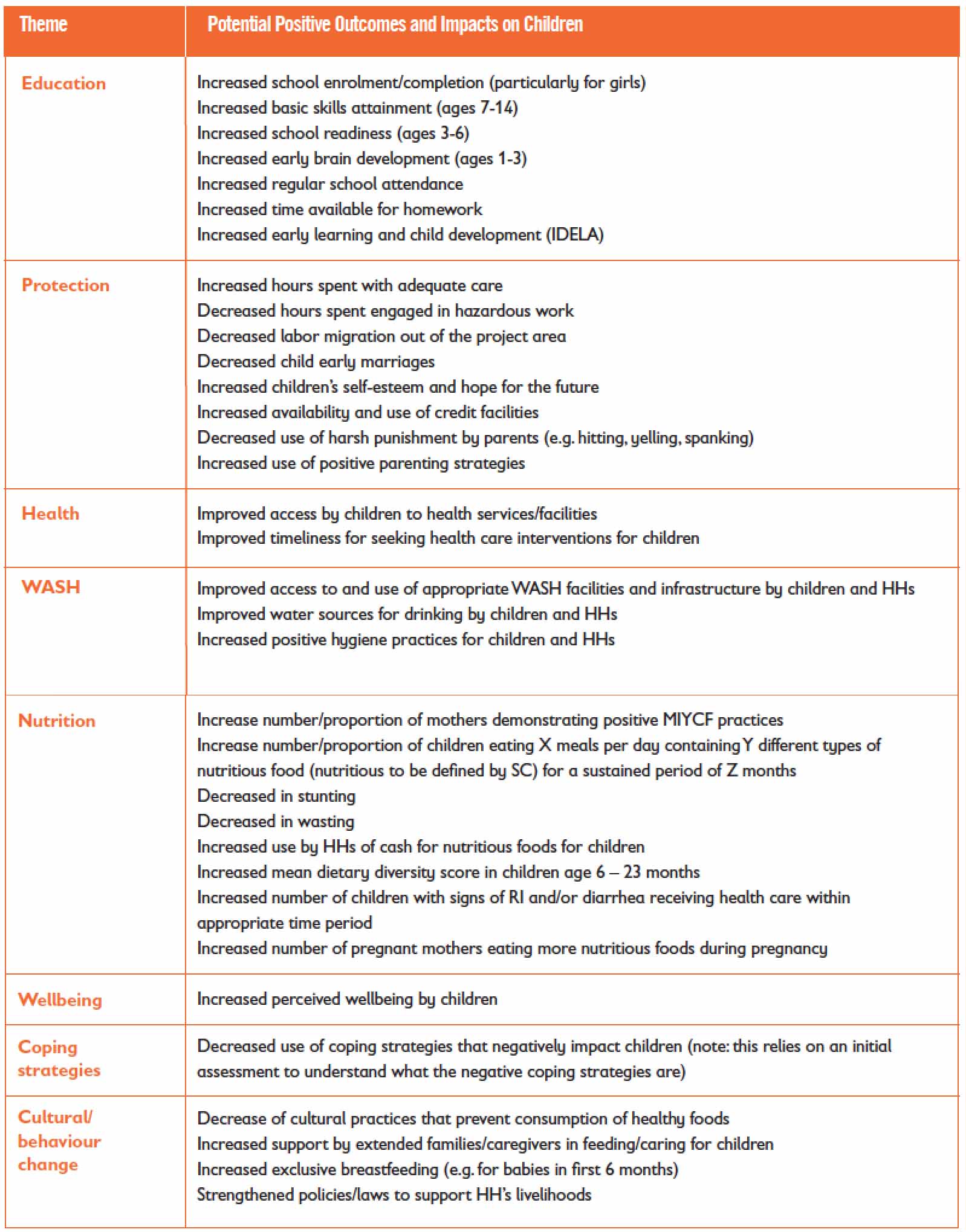Design Tool 5.1: Theory of Change Model
ToC Step 1 – Develop a Theory of Change for a child-sensitive PA project
Project teams should use the following guidelines to fill in each level of the ToC model.
Interventions: Identify activities that will work towards the desired change (directly or indirectly involving children) (Tip: Use the interventions identified in Design Action 3: Objective Tree).
Outputs: Identify the products, goods, services, information and skills that are provided directly to beneficiaries of the intervention(s). When relevant, state which outputs target children (directly and/or indirectly).
Outcomes: Identify the changes that will result from the intervention(s) and outputs. Outcomes can be multiple and sequential (short-term, medium-term and long-term/ intermediate or final). All child-sensitive PA projects should include positive outcomes for children and highlight all possible unintended risks and negative outcomes on children in the ToC.
Impact: Identify the ultimate/long-term effect of the PA programme, particularly at the child level. The impact(s) can be both intended and un-intended effects.
ToC Step 2 – Ensure impacts for children are evident in a child-sensitive ToC for PA programmes
Project teams working on child sensitivity in PA programmes, should design programmes that intentionally aim for positive impacts for children within HHs and not only for HHs as a whole.
To this end, project teams should consider the potential impacts that could occur in different facets of children’s lives (and within HHs) as a result of PA intervention(s). They should also consider differentiated impacts on different groups of children (e.g. children with disabilities, girls, children from marginalized/disadvantaged social or economic groups).
The table below provides examples of potential impacts of PA programmes on children. Project teams should clearly articulate the desired and realistic child-level impacts of each PA intervention to ensure these are integrated carefully into the project design. Also, identifying desired impacts supports project teams to develop child-sensitive MEAL frameworks and baseline studies (see below).
 Table 1. Examples of potential impacts of PA projects on children’s survival, learning and protection. Reference sheets for some of these indicators were developed and can be found in Tool 6.1 Menu of Child-sensitive Indicators Manual. For indicators specifically referring to Education, Health and Protection outcomes, project teams should consult the relevant Global Theme MEAL Advisors.
Table 1. Examples of potential impacts of PA projects on children’s survival, learning and protection. Reference sheets for some of these indicators were developed and can be found in Tool 6.1 Menu of Child-sensitive Indicators Manual. For indicators specifically referring to Education, Health and Protection outcomes, project teams should consult the relevant Global Theme MEAL Advisors.ToC Step 3 – Integrate assumptions and risks into the child-sensitive ToC for PA programmes
Designing safe, effective, child-sensitive PA programmes requires project teams to consider relevant assumptions and risks. This also means that project teams should consider assumptions and risks as part of the process of developing a sound ToC. Based on the Kenya case study, the example below shows how project teams should integrate assumptions and risks into the child-sensitive ToC. Project teams should use the assumptions and risks they identified in Action 4: Plan to address risks and question assumptions.
Highlighting these risks and assumptions in the ToC model will help project teams flag points in the causal chain that they will need to pay particular attention to.
ToC Step 4 – Verify and validate the ToC with the community
Engaging the target community/communities is essential for developing and implementing effective child sensitive PA interventions. This allows project teams and communities to work together in an inclusive and participatory manner in order to identify needs and activities and to define success in their contexts. In particular, project teams should engage children, caregivers and community members when realistic and safe to solicit their opinions and feedback.
In the context of the ToC, project teams should engage with children and communities to verify and validate the various aspects of their ToCs. Project teams should remember to adjust risks and assumptions, as well as the ToC to reflect the community inputs. Also, project teams should strive to engage all target communities of a PA programme (to the extent possible). This is important because risks and assumptions may differ from one community to another. For example, in the Kenya case study, the project implementation takes place in rural and urban communities, and the risks and assumptions related to Savings and IGA lead to different nutrition results for the children in the different communities (e.g. urban communities live in closer proximity to markets than rural communities, rural communities face greater constraints/risks related to getting to markets).
As a starting point for engaging children and communities, project teams can use the following questions:
- Do the project plans address the community and children’s biggest needs?
- Within the HH who is the appropriate target for such a project? • Would the community value such a project? If yes, why? If no, what are alternative approaches?
- Are the assumptions accurate?
- Are the pathways of change feasible and likely to succeed?
- What positive benefits will the project have for children?
- What potential negative impacts could the project have on children, HHs, adults (beyond the identified risks)? How can the project design better mitigate these potential negative impacts?
- What are the appropriate child outcome indicators (disaggregate for boys and girls, age etc)?
Comments (0)